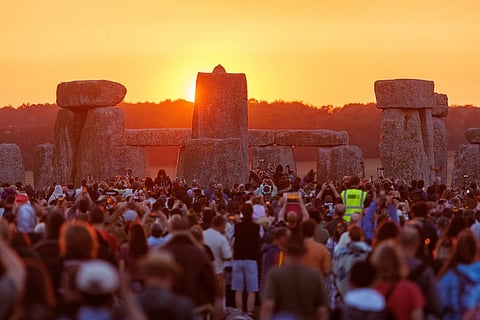
- LIFESTYLE
- FASHION
- FOOD
- ENTERTAINMENT
- EVENTS
- CULTURE
- VIDEOS
- WEB STORIES
- GALLERIES
- GADGETS
- CAR & BIKE
- SOCIETY
- TRAVEL
- NORTH EAST
- INDULGE CONNECT

Saturday was the longest day of the year in the Northern Hemisphere and cheers erupted at Stonehenge, where the ancient site has witnessed summer solstice celebrations for millennia.
Thousands gathered at the UNESCO World Heritage Site before daybreak to celebrate the arrival of summer, even as the U.K. faced its first amber heat-health alert since September 2023.
The rising sun appeared on the northeastern horizon, directly behind the Heel Stone, the monument’s entrance, and cast a beam of light into the center of the iconic stone circle. This rare event is one of the few times each year that visitors are permitted to step inside the usually restricted stones.
Later that day, temperatures soared to 33°C (91.4°F) in Surrey, located 80 miles (128 kilometers) east of Stonehenge, which the highest recorded in Britain so far this year.
English Heritage, the organization that manages the site, reported that around 25,000 people attended the solstice event in person, including druids, pagans, hippies, locals, and tourists. An additional 400,000 people watched the sunrise online.
“This morning was a joyous and peaceful occasion with the most beautiful sunrise,” said Richard Dewdney, head of operations at Stonehenge. “It is fantastic to see Stonehenge continuing to enchant and connect people.”
Stonehenge was constructed in phases starting around 5,000 years ago on the flat expanse of Salisbury Plain, roughly 75 miles (120 kilometers) southwest of London. The famous stone circle was set up during the late Neolithic era, around 2,500 B.C.
Some of the bluestones used in the monument originated in the Preseli Hills of southwest Wales, nearly 150 miles (240 kilometers) away, while the altar stone has recently been traced to northern Scotland, about 460 miles (740 kilometers) distant.
The purpose of Stonehenge has long sparked debate, with theories ranging from it being a royal coronation site for Danish monarchs, a druidic temple, a center for healing rituals, or even an ancient astronomical tool for tracking eclipses and solar alignments.
However, the most widely accepted belief remains that Stonehenge served as a temple aligned with the sun’s movements — precisely positioned to mark the summer and winter solstices.